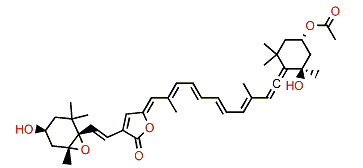
| Peridinin |
| Formula: | C39H50O7 |
| CAS#: | 33281-81-1 |
| MW: | 630.81 |
[MS]
|
|
Species utilize Peridinin in its chemical communication system
| Actiniaria, Actiniidae | |
| Anemonia sulcata |
P
¦Category of the chemical signal
| A - | Attractant |
| Al - | Allomone |
| K - | Kairomone |
| P - | Pheromone |
| Sy - | Synomone¦ |
|
¦(*) indicates that compound is active¦
|
Snakelocks anemone |
| |
| Alcyonacea, Nephtheidae | |
| Litophyton arboreum |
P
¦Category of the chemical signal
| A - | Attractant |
| Al - | Allomone |
| K - | Kairomone |
| P - | Pheromone |
| Sy - | Synomone¦ |
|
¦(*) indicates that compound is active¦
|
Broccoli coral |
| |
| Amphidiniales, Amphidiniaceae | |
| Amphidinium sp |
P
¦Category of the chemical signal
| A - | Attractant |
| Al - | Allomone |
| K - | Kairomone |
| P - | Pheromone |
| Sy - | Synomone¦ |
|
¦(*) indicates that compound is active¦
|
|
| |
| Cardiida, Cardiidae | |
| Hippopus hippopus |
P
¦Category of the chemical signal
| A - | Attractant |
| Al - | Allomone |
| K - | Kairomone |
| P - | Pheromone |
| Sy - | Synomone¦ |
|
¦(*) indicates that compound is active¦
|
Horse hoof clam |
| |
| Gorgonacea, Gorgoniidae | |
| Phyllogorgia dilatata |
P
¦Category of the chemical signal
| A - | Attractant |
| Al - | Allomone |
| K - | Kairomone |
| P - | Pheromone |
| Sy - | Synomone¦ |
|
¦(*) indicates that compound is active¦
|
|
| |
| Poecilosclerida, Iotrochotidae | |
| Iotrochota baculifera |
P
¦Category of the chemical signal
| A - | Attractant |
| Al - | Allomone |
| K - | Kairomone |
| P - | Pheromone |
| Sy - | Synomone¦ |
|
¦(*) indicates that compound is active¦
|
Purple-staining sponge |
| |
| Scleractinia, Pocilloporidae | |
| Pocillopora sp |
P
¦Category of the chemical signal
| A - | Attractant |
| Al - | Allomone |
| K - | Kairomone |
| P - | Pheromone |
| Sy - | Synomone¦ |
|
¦(*) indicates that compound is active¦
|
|
| |
| Suberitida, Halichondriidae | |
| Halichondria moorei |
P
¦Category of the chemical signal
| A - | Attractant |
| Al - | Allomone |
| K - | Kairomone |
| P - | Pheromone |
| Sy - | Synomone¦ |
|
¦(*) indicates that compound is active¦
|
|
| |
| Thoracosphaerales, Thoracosphaeraceae | |
| Thoracosphaera heimii |
P
¦Category of the chemical signal
| A - | Attractant |
| Al - | Allomone |
| K - | Kairomone |
| P - | Pheromone |
| Sy - | Synomone¦ |
|
¦(*) indicates that compound is active¦
|
|
| |
| Venerida, Corbiculidae | |
| Corbicula japonica |
P
¦Category of the chemical signal
| A - | Attractant |
| Al - | Allomone |
| K - | Kairomone |
| P - | Pheromone |
| Sy - | Synomone¦ |
|
¦(*) indicates that compound is active¦
|
Japanese blue clam |
| |
| Zoantharia, Sphenopidae | |
| Palythoa mutuki |
P
¦Category of the chemical signal
| A - | Attractant |
| Al - | Allomone |
| K - | Kairomone |
| P - | Pheromone |
| Sy - | Synomone¦ |
|
¦(*) indicates that compound is active¦
|
Broad zoanthid |
| |
| Cardiida, Cardiidae, Tridacninae | |
| Tridacna crocea |
P
¦Category of the chemical signal
| A - | Attractant |
| Al - | Allomone |
| K - | Kairomone |
| P - | Pheromone |
| Sy - | Synomone¦ |
|
¦(*) indicates that compound is active¦
|
Boring clam |
| |
| Mytilida, Mytilidae, Mytilinae | |
| Mytilus edulis |
P
¦Category of the chemical signal
| A - | Attractant |
| Al - | Allomone |
| K - | Kairomone |
| P - | Pheromone |
| Sy - | Synomone¦ |
|
¦(*) indicates that compound is active¦
|
Common blue mussel |
| |
|







